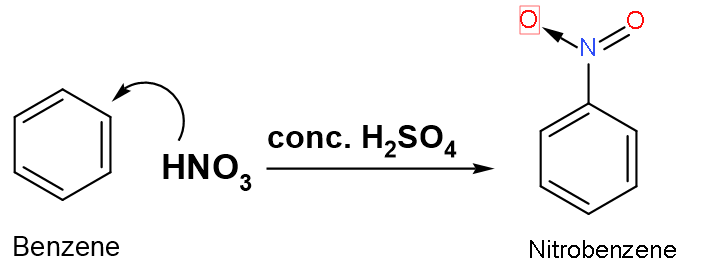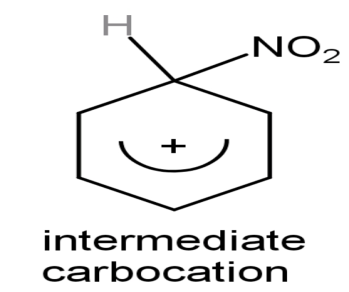
Nitration of benzene is carried out with conc.
A. nucleophile during the reaction
B. free radical during the reaction
C. electrophile during the reaction
D. catalyst during the reaction
Answer
504.3k+ views
Hint: The role of
Complete answer:
Nitration of benzene is a type of electrophilic substitution reaction. A substitution reaction in which aromatic compounds hydrogen of benzene nucleus is replaced with a nitro group of concentrated nitric acid in presence of concentrated sulphuric acid which yields nitro derivatives is known as ‘nitration’. The ratio of concentrated nitric acid and concentrated sulphuric acid is (1:2) in the mixture as reagents of the reaction.

Let us look at the mechanism of the reaction:
Step (1): Formation of electrophile: In nitration, nitronium ion is the electrophile. It is produced by the reaction of nitric acid with sulphuric acid.
Step (2): Formation of carbonium ion: On attacking of electrophile which is

The intermediate carbonium ion is

Step (3): Formation of final product: On attacking the nucleophile that is on the intermediate carbocation and giving the final product by attraction of the proton.

Thus, the concentrated sulphuric acid or
So, the correct answer is “Option D”.
Note:
The resonating structures should be made correctly and carefully. The main step is to obtain the electrophile which will be substituted on the benzene. Electrophile does not mean the one with a positive sign on it but the one whose orbitals are empty or electron deficient, like
Complete answer:
Nitration of benzene is a type of electrophilic substitution reaction. A substitution reaction in which aromatic compounds hydrogen of benzene nucleus is replaced with a nitro group of concentrated nitric acid in presence of concentrated sulphuric acid which yields nitro derivatives is known as ‘nitration’. The ratio of concentrated nitric acid and concentrated sulphuric acid is (1:2) in the mixture as reagents of the reaction.

Let us look at the mechanism of the reaction:
Step (1): Formation of electrophile: In nitration, nitronium ion is the electrophile. It is produced by the reaction of nitric acid with sulphuric acid.
Step (2): Formation of carbonium ion: On attacking of electrophile which is

The intermediate carbonium ion is

Step (3): Formation of final product: On attacking the nucleophile that is on the intermediate carbocation and giving the final product by attraction of the proton.

Thus, the concentrated sulphuric acid or
So, the correct answer is “Option D”.
Note:
The resonating structures should be made correctly and carefully. The main step is to obtain the electrophile which will be substituted on the benzene. Electrophile does not mean the one with a positive sign on it but the one whose orbitals are empty or electron deficient, like
Recently Updated Pages
Master Class 4 Maths: Engaging Questions & Answers for Success

Master Class 4 English: Engaging Questions & Answers for Success

Master Class 4 Science: Engaging Questions & Answers for Success

Class 4 Question and Answer - Your Ultimate Solutions Guide

Master Class 11 Economics: Engaging Questions & Answers for Success

Master Class 11 Business Studies: Engaging Questions & Answers for Success

Trending doubts
Give 10 examples of unisexual and bisexual flowers

Draw a labelled sketch of the human eye class 12 physics CBSE

a Tabulate the differences in the characteristics of class 12 chemistry CBSE

Differentiate between homogeneous and heterogeneous class 12 chemistry CBSE

Why is the cell called the structural and functional class 12 biology CBSE

Differentiate between insitu conservation and exsitu class 12 biology CBSE




